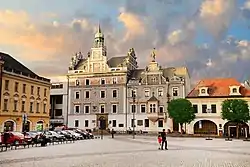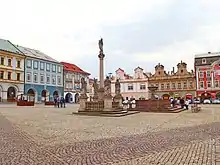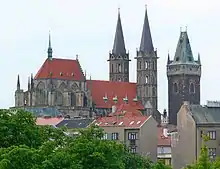Kolín
Kolín (Czech pronunciation: [ˈkoliːn]; German: Kolin, Neu Kolin) is a town in the Central Bohemian Region of the Czech Republic. It has about 33,000 inhabitants. The historic town centre is well preserved and is protected by law as an urban monument reservation.
Kolín | |
|---|---|
 Town hall on the Karlovo Square | |
 Flag  Coat of arms | |
 Kolín Location in the Czech Republic | |
| Coordinates: 50°1′41″N 15°12′2″E | |
| Country | |
| Region | Central Bohemian |
| District | Kolín |
| First mentioned | 1261 |
| Government | |
| • Mayor | Michael Kašpar (STAN) |
| Area | |
| • Total | 34.99 km2 (13.51 sq mi) |
| Elevation | 220 m (720 ft) |
| Population (2023-01-01)[1] | |
| • Total | 33,289 |
| • Density | 950/km2 (2,500/sq mi) |
| Time zone | UTC+1 (CET) |
| • Summer (DST) | UTC+2 (CEST) |
| Postal code | 280 02 |
| Website | www |
Administrative parts

Kolín is made up of town parts of Kolín I–VI and of villages of Sendražice, Šťáralka, Štítary and Zibohlavy.
Etymology
The name Kolín probably comes from the Old Czech verb koliti, i.e. "to hammer poles", and is related to the location of Starý Kolín in the often flooded area at the confluence of the Klejnárka and Elbe rivers. The soil in the vicinity of the confluence was strengthened with the help of wooden poles.[2]
Geography
Kolín lies about 47 kilometres (29 mi) east of Prague. It lies in a fertile landscape of the Central Elbe Table lowland. The town is located on the Elbe River. In the eastern part of the municipal territory is Sandberk, an artificial lake created by flooding a sandstone quarry.
History
Ptolemy's world map of the 2nd century mentions Budorgis in the area of today's Kolín.[3]
Kolín was founded by King Ottokar II of Bohemia in the 13th century by relocation, when Starý Kolín ("Old Kolín") was threatened by floods and the king decided to move the settlement. The first written mention of Kolín is from 1261, when it was mentioned that Přelouč obtained town privileges, just like Kolín and Kouřim have. It lay on a trade route Prague–Český Brod–Čáslav–Moravia.[4]
In 1437–1438, a castle was founded in Kolín. It was built on the ruins of a burned down monastery. During the Thirty Years' War, it was damaged, and in the 17th century, it was rebuilt as a brewery. In 1911, the castle burned down and its Renaissance look disappeared.[5]
The 1757 Battle of Kolín was fought during the Seven Years' War, and in 1944 a refinery in Kolín was bombed during the Oil Campaign of World War II. Zyklon B for the Nazi concentration camps was produced there.
Demographics
|
|
| ||||||||||||||||||||||||||||||||||||||||||||||||||||||
| Source: Censuses[6][7] | ||||||||||||||||||||||||||||||||||||||||||||||||||||||||
Economy

In Kolín is the smaller part of Kolín-Ovčáry Industrial Zone, known mostly for the factory of the automobile manufacturing company Toyota Motor Manufacturing.[8] As of 2020, TMM employed 2,400 people. It is the most important employer in the region.[9]
Kolín is home to the packaging and paper manufacturer, OTK company.
Sights
The historical centre of the town has many gothic and baroque buildings. Most notable are the main market (Karlovo Square) with the Neo-Renaissance town hall, and the Church of Saint Bartholomew from the 13th century, rebuilt in 1360 by the architect Peter Parler.[4][10]
In Kolín is the original Jewish ghetto with a synagogue from 1696. It is the second oldest and most valuable synagogue in Bohemia.[11] The Jewish cemetery is one of the oldest and largest Jewish cemeteries in Bohemia. It was established in the first half of the 15th century.[12]
Notable people
- Jakub Krčín (1535–1604), pond and dam constructer
- Jean-Gaspard Deburau (1796–1846), Czech–French actor and mime
- Vincenc Morstadt (1802–1875), painter and illustrator
- František Kmoch (1848–1912), composer and conductor; worked and died here
- Julius Petschek (1856–1932), industrialist
- Josef Svatopluk Machar (1864–1942), poet
- Václav Radimský (1867–1946), painter
- Terezie Brzková (1875–1966), actress
- Robert Saudek (1880–1935), graphologist and writer
- Otokar Fischer (1883–1938), playwright, translator and poet
- Josef Sudek (1896–1976), photographer
- Václav Morávek (1904–1942), soldier and war hero
- Ludmila Dvořáková (1923–2015), operatic soprano
- Frank Daniel (1926–1996), Czech-American screenwriter and film director
- Jan Kubíček (1927–2013), constructivist painter and sculptor
- Jiří Balcar (1929–1968), graphic artist, painter and illustrator
- Luboš Dobrovský (1932–2020), politician and journalist
- Eva Randová (born 1936), operatic mezzo-soprano
- Miloš Zeman (born 1944), President of the Czech Republic
- Jan Novák (born 1953), Czech-American novelist and playwright
- Jarda Svoboda (born 1966), musician
- Bohdan Ulihrach (born 1975), tennis player
- Petr Čáslava (born 1979), ice hockey player
- Barbora Poláková (born 1983), actress and singer
Twin towns – sister cities
.svg.png.webp) Dietikon, Switzerland
Dietikon, Switzerland Duino-Aurisina, Italy
Duino-Aurisina, Italy Érd, Hungary
Érd, Hungary Kamenz, Germany
Kamenz, Germany Lubań, Poland
Lubań, Poland Rimavská Sobota, Slovakia
Rimavská Sobota, Slovakia
References
- "Population of Municipalities – 1 January 2023". Czech Statistical Office. 23 May 2023.
- "Základní informace" (in Czech). Město Kolín. Retrieved 9 June 2022.
- Kleineberg, Andreas; Marx, Christian; Lelgemann, Dieter; Knobloch, Eberhard (2010). Germania und die Insel Thule. Die Entschlüsselung von Ptolemaios' "Atlas der Oikumene" (in German). Darmstadt: Wissenschaftliche Buchgesellschaft. ISBN 978-3-534-23757-9.
- "Historie" (in Czech). Město Kolín. Retrieved 28 June 2021.
- "Hrad Kolín" (in Czech). Hrady.cz. Retrieved 28 June 2021.
- "Historický lexikon obcí České republiky 1869–2011 – Okres Kolín" (in Czech). Czech Statistical Office. 21 December 2015. pp. 5–6.
- "Population Census 2021: Population by sex". Public Database. Czech Statistical Office. 27 March 2021.
- "Investoři v zóně" (in Czech). Kolín-Ovčáry Industrial Zone. Retrieved 28 June 2021.
- "Automobilka TPCA investuje v Kolíně 4,5 miliardy a najme 1000 pracovníků" (in Czech). Echo 24. 14 February 2020. Retrieved 28 June 2021.
- "Návštěvník" (in Czech). Město Kolín. Retrieved 28 June 2021.
- "Synagoga" (in Czech). Město Kolín. Retrieved 28 June 2021.
- "Starý židovský hřbitov" (in Czech). Město Kolín. Retrieved 28 June 2021.
- "Partnerská města" (in Czech). Město Kolín. Retrieved 27 September 2022.